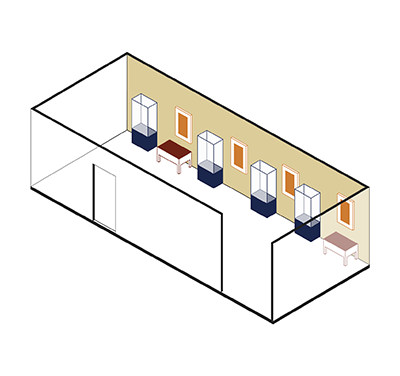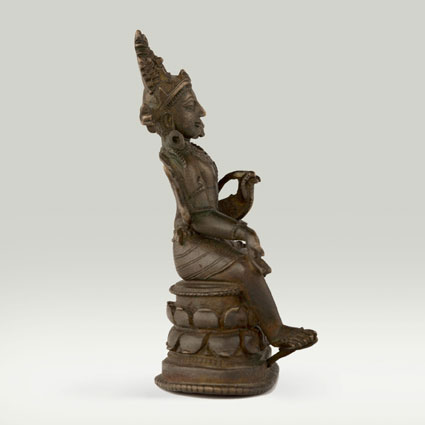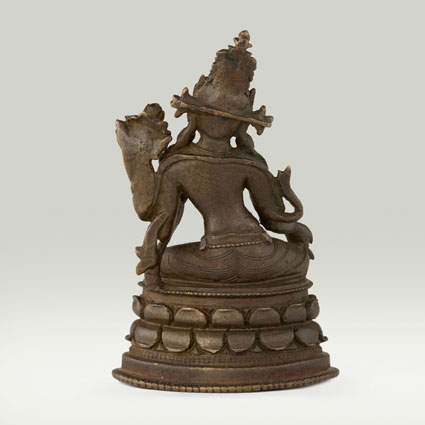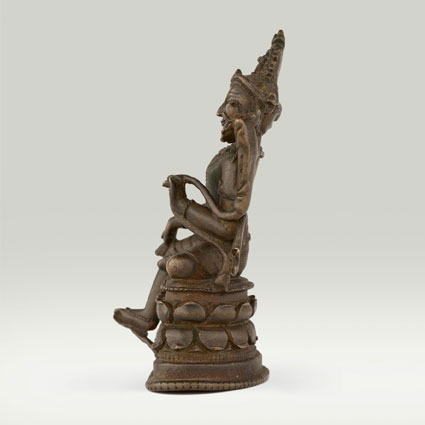Avalokiteshvara Padmapani – The "Lotus Bearer"
See it in the Museum

India and Nepal
Orientation 3
Display 3

ABS 045
Code: ABS 045
Country: India (north-east)
Style: Late Pala Style
Date: 1000 - 1100
Dimensions in cm WxHxD: 5 x 7.6 x 2.7
Materials: Brass
Avalokiteshvara Padmapani the Lotusbearer, is a bodhisattva that embodies the compassion of all Buddhas. He is the one of the most revered bodhisattvas in Mahayana Buddhism.
He is seated in the attitude of ease (lalitasana) on a double lotus pedestal with a beaded border, one foot resting on the lower level of the throne. He holds his attribute, the lotus flower (padma) with the uplifted left hand. With his right hand, he displays the gesture of charity (varada-mudra). He is clad with a cloth which is around the waist with a beaded belt. He wears princely ornaments: a pair of earrings, a necklace with attached pendants, and ornaments on both upper arms, and the “investiture with the sacred thread” (upavita). In the manner of Indian ascetics, he wears his hair knotted in a matted crown (jatamukuta), in which is placed a small effigy of Amitabha surmounted by the “wish-granting jewel” (cintamani).
Bodhisattvas are beings that have generated bodhicitta (mind of enlightenment), and vowed to help all sentient beings until each and every one is free from suffering. Bodhisattvas can live incarnated in this world or dwell in a subtle body in the realm of sambogakaya, where they can be reached through meditation. Bodhisattvas are also named “the Buddhas lions”. Bodhisattvas put into practise the six basic paramitas (virtues): charity, morality, patience, effort, concentration and wisdom (dana, sila, ksanti, verya, dhyana and prajna) and the four paramitas which derive from the basic ones: skillfull means, vows, power and knowledge (upaya, pranidhana, bala and jnana). Among the many, there are eight great or divine bodhisattvas. In the Nispanna Yogavali of Mahapandita Abhayakara Gupta three sets of sixteen bodhisattvas are mentioned.
He is seated in the attitude of ease (lalitasana) on a double lotus pedestal with a beaded border, one foot resting on the lower level of the throne. He holds his attribute, the lotus flower (padma) with the uplifted left hand. With his right hand, he displays the gesture of charity (varada-mudra). He is clad with a cloth which is around the waist with a beaded belt. He wears princely ornaments: a pair of earrings, a necklace with attached pendants, and ornaments on both upper arms, and the “investiture with the sacred thread” (upavita). In the manner of Indian ascetics, he wears his hair knotted in a matted crown (jatamukuta), in which is placed a small effigy of Amitabha surmounted by the “wish-granting jewel” (cintamani).
Bodhisattvas are beings that have generated bodhicitta (mind of enlightenment), and vowed to help all sentient beings until each and every one is free from suffering. Bodhisattvas can live incarnated in this world or dwell in a subtle body in the realm of sambogakaya, where they can be reached through meditation. Bodhisattvas are also named “the Buddhas lions”. Bodhisattvas put into practise the six basic paramitas (virtues): charity, morality, patience, effort, concentration and wisdom (dana, sila, ksanti, verya, dhyana and prajna) and the four paramitas which derive from the basic ones: skillfull means, vows, power and knowledge (upaya, pranidhana, bala and jnana). Among the many, there are eight great or divine bodhisattvas. In the Nispanna Yogavali of Mahapandita Abhayakara Gupta three sets of sixteen bodhisattvas are mentioned.





